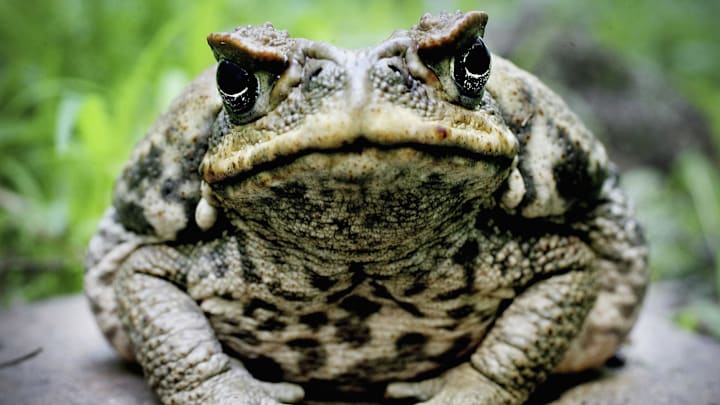What is likely the world’s largest cane toad—dubbed Toadzilla—weighed just shy of six pounds when it was found in Conway National Park in Queensland, Australia, in January 2023. “I reached down and grabbed the cane toad and couldn‘t believe how big and heavy it was,” ranger Kylee Gray said in a statement. The Queensland government believed the ample amphibian “could set a new record.”
Cane toads (Rhinella marina), native to Central and South America, are a prolific invasive species in Australia, Fiji, Hawaii, and Florida. Like environmental wrecking balls, the toxic toads threaten native fauna. Here are the essential facts.
1. People once used cane toad poison to coat arrowheads.
“The Choco Indians of western Colombia used to ‘milk’ toads by placing them in bamboo tubes over an open fire,” Christopher Lever writes in The Cane Toad: The History and Ecology of a Successful Colonist. Concentrated poison trickled into a bottle, and the dangerous substance was smeared over arrowheads and blowgun darts.
2. They’re the world’s biggest true toads.

The average wild cane toad usually reaches a length of 4 to 6 inches and weighs about three pounds. Some specimens have grown much larger, though. Before Toadzilla, the biggest one on record weighed more than five pounds. The toads are sexually dimorphic; females are usually larger. Males also have rougher skin and make an assortment of vocalizations.
3. About 1.5 billion cane toads roam Australia.

In 1900, Australia’s sugar cane growers asked the government for solutions to the frequent beetle and insect infestations that killed their crops. The Bureau of Sugar Experiment Stations (BSES) tried various pesticides, but none worked. Then, in 1935, staff entomologist Reginald Mungomery was sent to Hawaii with instructions to round up some cane toads, which had been introduced there to save the islands‘ sugar crops from the same insect problems. The BSES set up a captive breeding program with the imported toads, and later that year, unleashed 102 cane toads in northern Queensland. Their population skyrocketed, and totals about 1.5 billion toads today.
4. Female can toads can lay 8000 to 30,000 eggs at one time.

A few days after a female cane toad lays her eggs, they hatch into tadpoles, a chapter in the life cycle that lasts for four to eight weeks. The tadpoles are prone to cannibalism, and have been known to eat the eggs and tadpoles of other cane toads (they don‘t eat their own siblings, though). While the young can make short work of each other, anything else that tries to eat them is in for a bad experience: Both cane toad eggs and tadpoles are poisonous.
5. Some people try to get high by licking cane toads. It doesn’t end well.
When threatened, cane toads secrete a dangerous cocktail of chemicals, including 5-methoxy-N, N-dimethyltryptamine. People who ingest this compound, usually by licking the toads, experience strong hallucinations and a full-body rush. Unfortunately, their symptoms may also include severely weakened muscles, intense vomiting, seizures, and death by heart stoppage. Keep your tongue away from the toads!
6. Cane toads will eat dog food.
These toads aren’t picky eaters, and they are happy to devour anything that can fit into their mouths, including beetles, bees, ants, crickets, frogs, snakes, aquatic snails, and even small dogs and cats. In residential areas, cane toads are often seen climbing into dog food bowls and chowing down on the contents.
7. King Charles III received a cane toad-themed wedding present.

Cane toads’ hides can be turned into a bumpy, poison-free leather. As a wedding gift to the then-Prince Charles on his marriage to Diana Spencer in 1981, the Australian Defense Department offered the royal couple a handsome book bound in the skins of four cane toads.
8. Invasive cane toads are being used in daring recipes.
For reasons previously stated, you’ll want to keep live cane toads as far away from your mouth as possible. But—if they’re properly prepared—cane toads are actually edible. In recent years, Australian chefs have incorporated cane toad legs into their entrées. These juicy treats may be sautéed, stir fried, or thrown into a nice salad. “It’s healthy foodstuff,” Philip Hayward, an island studies professor at Southern Cross University, told ABC. “We can severely reduce numbers … and at the same time have a healthy, economically viable product.”
9. There’s a cane toad statue in Sarina, Australia.
“Buffy,” as residents call her, commemorates the town’s sugar cane farmers. It began life in 1983 as a papier-mâché ornament on a float in that year’s Apex Sugar Festival. The model was then cast in fiberglass and moved to Broad Street in central Sarina.
10. Cane toad poison might have medical value.

Researchers at the University of Queensland have been assessing the medical benefits of this notorious toxin since 2010. Experiments have shown that cane toad poison selectively kills cancer cells while leaving healthy cells intact.
“We could process the [toxin] for medicine, ideally in a tablet because it tastes absolutely awful,” Dr. Harenda Parekh, a senior lecturer at the school of pharmacy, told The Guardian in 2016. The product would be similar to chan su, a traditional Chinese medicine made with poison from an indigenous Asian toad, to treat skin conditions, heart failure, and sore throats. Poison from Australian cane toads may offer an alternative source and save the native amphibian. “The cane toad is a pest here to stay and we are fighting a losing battle against it,” Parekh said, “but we could turn them into a lucrative export.”
